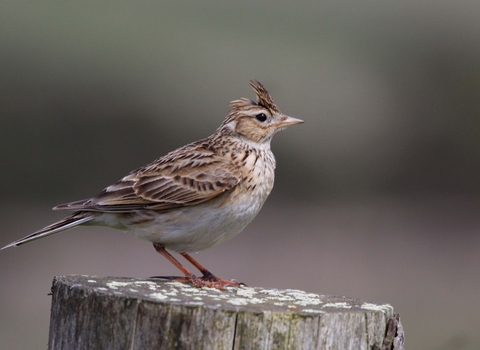
©Margaret Holland
Skylark
Scientific name
Alauda arvensisWhen to see
January to DecemberSpecies information
Statistics
Length: 18cmWingspan: 33cm
Weight: 35-42g
Average lifespan: 2 years
About
Male skylarks can be spotted rising almost vertically from farmland, grassland, saltmarshes and moorland. They hover effortlessly, singing from a great height, before parachuting back down to earth. These long and complicated song-flights can last for up to an hour and the birds can reach 300m before descending. They'll also sing from perches, such as fence posts or large rocks. Despite their aerial activities, skylarks nest on the ground, laying three to four eggs. Chicks become independent after only two weeks and parents can have up to four broods in a breeding season.How to identify
If seen in song-flight, the skylark is unmistakeable. A streaky brown bird, with a crest, it is larger than the similar woodlark (a rare bird of heathland and woodland edges) and has a longer tail. It is also much larger than the similar meadow pipit, which has a thinner bill and no crest.Distribution
Widespread.In our area
Some of the best places to hear skylarks in London are Wimbledon Common, Wanstead Flats, Yeading Brook Meadows, Richmond Park and Rainham Marshes. But if you're planning a visit, be aware that the skylark population in Britain has declined by over 50% since 1970. In London, the species is in danger of becoming extinct due, in part, to the large number of visitors that disturb their breeding activities at country parks and on commons. Please keep yourself and your dog away from the long grass and heath here.
Did you know?
The song of the skylark has been the subject of many works of literature and music from Chaucer to Shelley, Vaughan Williams to jazz.Some of the best places to hear skylarks in London are Wimbledon Common, Wanstead Flats, Yeading Brook Meadows, Richmond Park and Rainham Marshes. But if you're planning a visit, be aware that the skylark population in Britain has declined by over 50% since 1970. In London, the species is in danger of becoming extinct due, in part, to the large number of visitors that disturb their breeding activities at country parks and on commons. Please keep yourself and your dog away from the long grass and heath here.
